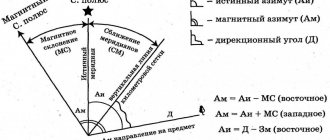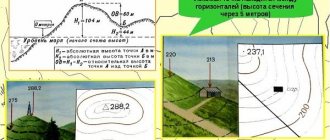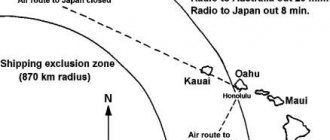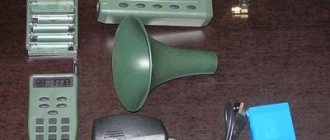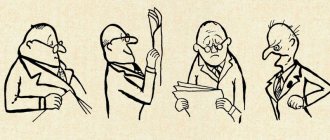Determining distances to targets
Military Encyclopedia - historical and archival military-patriotic portal
home☆Soviet military encyclopedia☆military equipment☆military science☆military review☆history of weapons☆forum
military science ☆ Sniper. Methodological preparation. ☆
Determining distances to targets during the day can be done in various ways: by eye, by the angular values of targets or local objects, by the rangefinder scale of an optical sight, by direct measurement of the terrain and by sound. The visual method of determining distance without the use of any instruments is one of the main ways of determining distances to a target. In practice, two methods are used to visually determine the distance to targets: by sections of terrain, by the degree of visibility and the apparent size of the target (Fig. 18). To develop your eye, you need to practice assessing “by eye” with mandatory double-checking in steps or using a map. First of all, you need to mentally set aside some familiar distance that has been strengthened in visual practice, for example, a segment of 100, 200 or 300 m from yourself to the target or local object. It should be taken into account that as the distance increases, the apparent size of the segment gradually decreases in the future.
When determining the distance by the degree of visibility and the apparent size of the target, it is necessary to compare the visible size of the target with the visible dimensions of this target imprinted in your memory at certain distances. During the training process, you must remember: s larger objects seem closer than small ones located at the same distance; ^ Objects appear closer and are visible more sharply and clearly. Objects of bright colors (white, yellow, red) seem closer than objects of dark colors (blue, black, brown). Brightly lit objects appear closer than dimly lit objects located at the same distance. The sharper the difference in the color of objects and the background of the area against which they are visible, the more reduced the distances to these objects seem (in winter, a snow field seems to bring all the darker objects on it closer). During fog, rain at dusk and cloudy days with saturated air, observed objects seem further away than on clear days; The fewer intermediate objects there are between the eye and the observed object, the closer this object seems. Objects on level ground seem closer, distances defined through a water obstacle (space) seem especially shortened, so the opposite shore always seems closer than it actually is. Folds of the terrain (hollows, ravines) crossing the measured line also seem to shorten the distances. When observed lying down, objects appear closer than when measured standing; when observed from bottom to top (from the base of the mountain to the top), objects appear closer, and when observed from top to bottom, objects appear further away. The visual method of determining distances can be controlled by the following methods:
- using several observers independently to determine the same distance, the average of all will be the most accurate result;
- comparison of the measured distance with another segment marked on the ground, the value of which is known (the distance between telegraph poles).
To estimate distances, you can use the approximate data given in table. 4.
Table 4. Visibility distances of objects and targets with the naked eye
The accuracy of the eye depends on the sniper’s training, the distance to the target and the observation conditions. When determining a distance of up to 1000 m, experienced snipers can have errors of up to 10-15%, with much larger ones up to 50%. To determine the distance by angular value, it is necessary to know the width or height of the target (object) to which the distance is measured, and to have observation devices. If the dimensions of a local object are known, the distance to it can be determined using thousandths (a thousandth is an angular value equal to 1/1000 of a radian or a central angle based on an arc equal to 1/6000 of a circle). To do this, you need to measure the angle at which the object is visible (in thousandths). Then multiply the pre-known size of the object in meters by a thousand (a constant number) and divide the result by the number of measured thousandths. These actions are expressed by the formula:
where D is the determined distance to the target in meters; B is the known height (length, width) of the target in meters; Y is the measured angular value in thousandths under which the target (object) is visible.
The angular magnitude of an object in thousandths can be determined using field binoculars or other observation equipment. In the field of view of the binoculars there is a goniometric grid (Fig. 19), which in turn has mutually perpendicular goniometric scales. The value of one large scale division corresponds to 10 thousandths (0-10), the small one corresponds to 5 thousandths (0-05). Use the goniometric scales of binoculars like this. For example, it is necessary to determine the distance to an enemy ATGM located at the line of telegraph poles. The distance between the pillars is 50 m. It is closed with large divisions of the horizontal goniometric scale (20 thousandths or 0-20). Distance to ATGM:
where B is the distance between the pillars; Y is the angle in thousandths at which the target is visible. In the absence of observation devices, angular values can be measured using improvised objects (pencil, matchbox, ruler, as well as fingers and palm). To do this, you need to remember their value in thousandths. The angular magnitudes of these objects when removed from the observer’s eye by an arm freely extended forward (50 cm) are equal to:
- pencil 0-10
- matches (thickness) 0-3.5
- thumb 0-40
- index finger 0-30
- middle and ring finger 0-35
- little finger 0-25
matchbox:
- along the length 0-90
- width 0-60
- height 0-30
To measure distance using a ruler (Fig. 20), you need to hold it in front of you at a distance of 50 cm from the eye, then one division (1 mm) will correspond to 0-02.
In the future, the calculation is made using the thousandth formula. Determining distances by the angular dimensions of objects gives accurate results only if the linear dimensions of the target are known (Table 5) and the angular measurements are made carefully.
Table 5 Linear dimensions of typical objects and local objects
To determine distances by measuring the terrain in steps, you need to know the average value of one pair of your steps in meters. When determining distances, count in pairs of steps. This method can only be used outside of contact with the enemy and to test the visual method. This way you can measure the width of the river. To do this, you need to stand on your bank opposite some local object (tree) located on the opposite bank near the water. From your standing place, measure some distance along the shore, for example 50 steps, and notice this point (install a peg); then measure another distance along the shore equal to half the measured one, i.e. in this case, equal to 25 steps. From this place, move away from the shore at a right angle until the previously noticed point (peg) is in alignment with an object (tree) located on the opposite bank. The distance traveled from the shore, doubled, will be equal to the width of the river. Determining distance by the sound and flash of a shot. This method allows you to quickly determine the distance to firing guns, machine guns, mortars and other targets that reveal themselves at the moment of firing with a flash and the formation of smoke rings. To determine the approximate distance, we can assume that the speed of sound in air is approximately 330 m/sec, i.e. 1 km in 3 seconds. Light travels almost instantly. Thus, by counting the second hand from the moment of the flash to the moment of auditory perception of the sound of the shot, we can calculate the distance (D) in kilometers to the target using the formula: D = t/3, where D is the distance to the target in km; t — time (in seconds), determined using a stopwatch; 3 - time (in seconds) during which sound will travel 1 km in the air. If, for example, the sound was heard 9 seconds after the flash, then D = 9/3 = 3 (km). If you don't have a clock, you can count time by counting two-digit numbers to yourself. For example: twenty-one, twenty-two, etc., which is approximately equal to one second of counting one number. Determination of distances by ear is carried out in conditions of limited visibility. To do this, you need to be able to distinguish their sources by the nature of sounds and know from what distances these sounds can be heard. With normal hearing and favorable acoustic conditions, the hearing range can be as shown in Tables 6 a and 6 b.
Table 6a. Hearing range of troop and equipment movement noise
Table 6b. Sound unmasking signs
The accuracy of determining the distance by ear depends on the training and hearing acuity of the sniper, his ability to take into account natural factors affecting the propagation and strength of sound. Such factors include the direction and strength of the wind, temperature and humidity, the nature of the location of relief folds, the presence of shielding surfaces that reflect sound, causing echoes and auditory deceptions, the presence of vegetation cover and its location. In cloudy weather or deep clouds (especially after rain), audibility increases, on a clear sunny day it worsens. At night and early in the morning, audibility is better than during the day, and in winter it is better than in summer. In mountainous areas, sounds are heard at a much greater distance than in the plains, since sound waves, reflected from the surface of the mountains, travel further. Vegetation and local objects in the path of movement can slow their spread and change direction. When located near bodies of water, in a forest, in the mountains or in deep folds of terrain, strong sound distortion occurs, both in strength and in direction. Audibility increases when the wind blows from the direction of the sound source, at night and in the early morning hours, in cloudy weather and especially after rain. With increased audibility caused by these reasons, sound sources seem closer than in reality. Sound is absorbed, i.e. becomes weaker, in hot sunny weather, during snowfall, rain, in forests, bushes, and in areas with sandy soil. As audibility decreases, distances to sound sources seem to increase.
Tags: sniper training ☆ sniper ☆
| The procedure for organizing and conducting observation of the battlefield < Prev. | Track. > Selecting sight settings, aiming points and determining lateral corrections |
Metal wardrobes
Production and sale of professional equipment for the restaurant business.
- Contacts:
- 8
- Moscow
© Military Encyclopedia. Map of site.
Problem conditions and initial data
The distance between the pupils is approximately six centimeters if a person looks straight ahead and does not suffer from strabismus. The distance from each eye to the raised thumb of an outstretched hand is approximately 60 centimeters.
Knowledge of these parameters and the information remaining in memory from a school geometry course is quite enough to determine the distance to the required object.
To determine the distance to the road along which a person is walking at this time, you can use two methods: by the distance between the trees, which are planted along the roads at a distance of 3.5 to 5 meters from each other, and the average speed of the person.
Top jeans 2021: a model that you can definitely buy (or make yourself)
What Kirill Safonov looks like now: the actor has transformed thanks to weight loss
For three years now I have been cooking squid so that in salads they are not bland and tough

